Traditional In Situ Water Harvesting Practices and Agricultural Sustainability in Sub-Saharan Africa—A Meta-Analysis
Abstract
:1. Introduction
2. Materials and Methods
2.1. Data Collection
- ○
- Only publications describing experiments conducted in the field with side-by-side comparisons of IS_WH and non-IS_WH practices were included; pot-level studies were excluded.
- ○
- Crop yield, soil moisture, soil loss, and runoff data under IS_WH and non-IS_WH practices were reported, and the primary data on crop yield, soil moisture, and runoff must be comparable.
- ○
- The mean, sample size, and a measure of dispersion (SE or SD) as numerical or graphical data were available, or the SD of data could be calculated from the reported data for IS_WH and non-IS_WH practices.
- ○
- Peer-reviewed articles published in English.
- ○
- Experiments conducted in the sub-Saharan African countries.
2.2. PRISMA Statement
2.3. Database Compilation
- Geographical distribution
- In situ water harvesting (IS_WH) practices
- Crop type and yield
- Fertilizer use
- Rainfall distribution
- Adoption rate
2.4. Data Analysis
3. Results and Discussion
3.1. Study Selection
3.2. Study Characteristics
3.3. Traditional In Situ Water Harvesting Practices’ Impact on Crop Yield
Yield Impact: Aggregated, with and without Fertilizer
3.4. Traditional In Situ Water Harvesting Practices’ Impact on Soil Moisture Retention
3.5. Traditional In Situ Water Harvesting Practices’ Impact on Runoff and Soil Loss
3.5.1. Impact of Traditional In Situ Water Harvesting Practices on Runoff Reduction
3.5.2. Impact of Traditional In Situ Water Harvesting Practices on Soil Loss Reduction
3.5.3. Regression Analysis
3.6. Publication Bias
3.6.1. Yield Data
3.6.2. Runoff, Soil Loss, and Soil Moisture Retention Data
3.7. Traditional In Situ Water Harvesting Practices’ Adoption Factors in Sub-Saharan Africa
| IS_WH | Adoption Rate (%) | Countries | User-Related | Technology-Related | Access-Related | Adoption Rate (%) |
|---|---|---|---|---|---|---|
| Infiltration pits | 24.75% | Ethiopia, Niger, Kenya, Malawi | Awareness of these practices among local communities, low access to training, and knowledge transfer opportunities for effective implementation and alignment of these practices with local traditions and cultural norms | Labor intensive, and availability accessibility of the necessary tools, materials, and resources required for construction, the presence of successful case studies, the simplicity and feasibility of implementing these practices since they are affected by various factors like rainfall amount and intensity | The affordability of the resources and inputs needed for these practices, and proximity to suitable land for implementing these techniques. The presence of policies and incentives that encourage the adoption of these techniques | [53,54,55] |
| Bunds (stone and soil) | 42.75% | Ghana, Ethiopia, Mali, Congo, Burkina Faso, Nigeria | Limited technical skills, education, social networks and extension contacts, and farm soil conditions mainly determine the extent to which bunds align with or conflict with traditional farming practices and local knowledge, and the degree of community participation, and support for bund construction and maintenance | Overambitious and myopic project planning, top-down approach, the accessibility of essential resources like stones, soil, and tools required for bund construction, low technical knowledge, and skills for proper bund design and construction for better suitability for the local ecological and topographical conditions and maintenance requirements | Capital and labor constraints, land ownership and tenure systems, the absence of governmental policies, incentives, and extension services aimed at promoting bund construction | [50,56,57,58,59,60] |
| Terraces | 58.72 | Rwanda, Ethiopia Uganda, Tanzania, Kenya | Level of understanding and awareness among local communities about terrace construction, participation and engagement, the degree of community involvement, and support for terrace construction and maintenance | The availability of technical knowledge and skills for designing and constructing effective terrace systems, suitability of terrace designs to the local topography and environmental conditions, and maintenance requirements | Current productivity of the land or availability of other lands for farming, available resources and their competing uses, labor constraints, and past approaches for promoting the interventions | [52,54,59,61,62,63,64] |
| Ridges | 52.4% | Ghana and Kenya | Farmers’ education, social networks and extension contacts, and farm soil conditions and their perception on the advantages of ridge systems | The presence of technical knowledge and skills required for proper ridge design and construction, the suitability of ridge designs to the local topography, climate, and soil conditions, and the level of effort and resources needed to maintain ridge systems over time | Capital and labor constraints, farm size, access to credit and materials, and the existence of government policies, incentives, and extension services aimed at promoting the adoption of ridge systems for sustainable agriculture | [51,63] |
| Mulching | 26.85 | Uganda Kenya, Malawi | Awareness among farmers about mulching techniques and their benefits in agriculture, and the extent to which mulching aligns with or conflicts with existing farming practices and traditions | Access to the necessary resources and materials for mulching, including organic mulch materials or synthetic mulching films, and the suitability of mulching techniques to the local ecological and agricultural context. The effort and resources needed to maintain mulch cover over the growing season. | Capital and labor constraints | [52,65] |
4. Conclusions
Supplementary Materials
Author Contributions
Funding
Data Availability Statement
Acknowledgments
Conflicts of Interest
References
- Jagermeyr, J.; Muller, C.; Ruane, A.C.; Elliott, J.; Balkovic, J.; Castillo, O.; Faye, B.; Foster, I.; Folberth, C.; Franke, J.A.; et al. Climate impacts on global agriculture emerge earlier in new generation of climate and crop models. Nat. Food 2021, 2, 873–885. [Google Scholar] [CrossRef] [PubMed]
- Bjornlund, V.; Bjornlund, H.; van Rooyen, A. Why food insecurity persists in sub-Saharan Africa: A review of existing evidence. Food Secur. 2022, 14, 845–864. [Google Scholar] [CrossRef] [PubMed]
- Beyer, M.; Wallner, M.; Bahlmann, L.; Thiemig, V.; Dietrich, J.; Billib, M. Rainfall characteristics and their implications for rain-fed agriculture: A case study in the Upper Zambezi River Basin. Hydrol. Sci. J. 2015, 61, 321–343. [Google Scholar] [CrossRef]
- Wainwright, C.M.; Allan, R.P.; Black, E. Consistent Trends in Dry Spell Length in Recent Observations and Future Projections. Geophys. Res. Lett. 2022, 49, e2021GL097231. [Google Scholar] [CrossRef]
- Akinsemolu, A.A.; Onyeaka, H.N.; Tamasiga, P. Climate-smart agriculture as a possible solution to mitigate climate change impact on food security in Sub-Saharan Africa. Food Energy Secur. 2023, 13, e509. [Google Scholar] [CrossRef]
- Laskari, M.; Menexes, G.; Kalfas, I.; Gatzolis, I.; Dordas, C. Water Stress Effects on the Morphological, Physiological Characteristics of Maize (Zea mays L.), and on Environmental Cost. Agronomy 2022, 12, 2386. [Google Scholar] [CrossRef]
- Moragoda, N.; Kumar, M.; Cohen, S. Representing the role of soil moisture on erosion resistance in sediment models: Challenges and opportunities. Earth-Sci. Rev. 2022, 229, 104032. [Google Scholar] [CrossRef]
- Berg, A.; Sheffield, J. Climate Change and Drought: The Soil Moisture Perspective. Curr. Clim. Change Rep. 2018, 4, 180–191. [Google Scholar] [CrossRef]
- Bedeke, S.B. Climate change vulnerability and adaptation of crop producers in sub-Saharan Africa: A review on concepts, approaches and methods. Environ. Dev. Sustain. 2022, 25, 1017–1051. [Google Scholar] [CrossRef]
- Piemontese, L.; Castelli, G.; Fetzer, I.; Barron, J.; Liniger, H.; Harari, N.; Bresci, E.; Jaramillo, F. Estimating the global potential of water harvesting from successful case studies. Glob. Environ. Chang. 2020, 63, 102121. [Google Scholar] [CrossRef]
- Mekuria, W.; Tegegne, D. Water harvesting. In Encyclopedia of Soils in the Environment; Academic Press: Cambridge, MA, USA, 2023; pp. 593–607. [Google Scholar] [CrossRef]
- Saskia, D.K.; Bouma, J.; Wallinga, J.; Tittonell, P.; Smith, P.; Cerdà, A.; Montanarella, L.; Quinton, J.N.; Pachepsky, Y.; Putten, W.H.v.d.; et al. The significance of soils and soil science towards realization of the United Nations Sustainable Development Goals. Soil Discuss. 2016, 2, 111–128. [Google Scholar]
- Vohland, K.; Barry, B. A review of in situ rainwater harvesting (RWH) practices modifying landscape functions in African drylands. Agric. Ecosyst. Environ. 2009, 131, 119–127. [Google Scholar] [CrossRef]
- Kugedera, A.T.; Sakadzo, N.; Kokerai, L.K.; Ranganai, N. Water Harvesting Technologies for Sustainable Crop Production in African Smallholder Farming Systems. In Towards Sustainable Food Production in Africa; Springer: Singapore, 2023; pp. 171–183. [Google Scholar] [CrossRef]
- Rockstrom, J.; Falkenmark, M. Agriculture: Increase water harvesting in Africa. Nature 2015, 519, 283–285. [Google Scholar] [CrossRef] [PubMed]
- Srivastav, A.L.; Dhyani, R.; Ranjan, M.; Madhav, S.; Sillanpaa, M. Climate-resilient strategies for sustainable management of water resources and agriculture. Environ. Sci. Pollut. Res. Int. 2021, 28, 41576–41595. [Google Scholar] [CrossRef] [PubMed]
- Bouma, J.A.; Hegde, S.S.; Lasage, R. Assessing the returns to water harvesting: A meta-analysis. Agric. Water Manag. 2016, 163, 100–109. [Google Scholar] [CrossRef]
- Lasage, R.; Aerts, J.C.J.H.; Verburg, P.H.; Sileshi, A.S. The role of small scale sand dams in securing water supply under climate change in Ethiopia. Mitig. Adapt. Strateg. Glob. Chang. 2015, 20, 317–339. [Google Scholar] [CrossRef]
- Belayneh, M. Factors affecting the adoption and effectiveness of soil and water conservation measures among small-holder rural farmers: The case of Gumara watershed. Resour. Conserv. Recycl. Adv. 2023, 18, 200159. [Google Scholar] [CrossRef]
- Kumar, S.; Singh, D.R.; Singh, A.; Singh, N.P.; Jha, G.K. Does Adoption of Soil and Water Conservation Practice Enhance Productivity and Reduce Risk Exposure? Empirical Evidence from Semi-Arid Tropics (SAT), India. Sustainability 2020, 12, 6965. [Google Scholar] [CrossRef]
- Manyanga, M.A.; Soropa, G.; Lawrence, M. Potential of In-Field Rainwater Harvesting to Improve Resilience of Dryland Cropping in Smallholder Farms of Zimbabwe: A Review. In Climate Change Adaptations in Dryland Agriculture in Semi-Arid Areas; Springer: Singapore, 2022; pp. 173–183. [Google Scholar] [CrossRef]
- Drechsel, P.; Olaleye, A.; Adeoti, A.; Thiombiano, L.; Barry, B.; Vohland, K. Adoption Driver and Constraints of Resource Conservation Technologies Insub-Saharan Africa; IWMI: Accra, Ghana, 2010. [Google Scholar]
- Rockstrom, J.; Lannerstad, M.; Falkenmark, M. Assessing the water challenge of a new green revolution in developing countries. Proc. Natl. Acad. Sci. USA 2007, 104, 6253–6260. [Google Scholar] [CrossRef]
- Nord, A.; Snapp, S.; Traore, B. Current knowledge on practices targeting soil fertility and agricultural land rehabilitation in the Sahel. A review. Agron. Sustain. Dev. 2022, 42, 79. [Google Scholar] [CrossRef]
- Ivaldi, D.; Burgos, M.; Oltra, G.; Liquitay, C.E.; Garegnani, L. Adherence to PRISMA 2020 statement assessed through the expanded checklist in systematic reviews of interventions: A meta-epidemiological study. Cochrane Evid. Synth. Methods 2024, 2, e12074. [Google Scholar] [CrossRef]
- Bado, B.V.; Bationo, A.; Whitbread, A.; Tabo, R.; Manzo, M.L.S. Improving the productivity of millet based cropping systems in the West African Sahel: Experiences from a long-term experiment in Niger. Agric. Ecosyst. Environ. 2022, 335, 107992. [Google Scholar] [CrossRef]
- Chilagane, E.A.; Saidia, P.S.; Kahimba, F.C.; Asch, F.; Germer, J.; Graef, F.; Swai, E.; Rweyemamu, C.L. Effects of Fertilizer Micro-dose and In Situ Rain Water Harvesting Technologies on Growth and Yield of Pearl Millet in a Semi-arid Environment. Agric. Res. 2020, 9, 609–621. [Google Scholar] [CrossRef]
- Kathuli, P.; Itabari, J.K. In Situ Soil Moisture Conservation: Utilization and Management of Rainwater for Crop Production. In Adapting African Agriculture to Climate Change; Springer: Cham, Switzerland, 2015; pp. 127–142. [Google Scholar] [CrossRef]
- Saiz, G.; Wandera, F.M.; Pelster, D.E.; Ngetich, W.; Okalebo, J.R.; Rufino, M.C.; Butterbach-Bahl, K. Long-term assessment of soil and water conservation measures (Fanya-juu terraces) on soil organic matter in South Eastern Kenya. Geoderma 2016, 274, 1–9. [Google Scholar] [CrossRef]
- Tadros, M.J.; Al-Mefleh, N.K.; Othman, Y.A.; Al-Assaf, A. Water harvesting techniques for improving soil water content, and morpho-physiology of pistachio trees under rainfed conditions. Agric. Water Manag. 2021, 243, 106464. [Google Scholar] [CrossRef]
- Palé, S.; Taonda, S.J.B.; Bougouma, B.; Mason, S.C. Water and fertilizer influence on sorghum grain quality for traditional beer (dolo) production in Burkina Faso. Afr. J. Food Sci. 2010, 4, 723–734. [Google Scholar]
- Drake, K. Mulching Reduces Dependency. Africa Windmill Project. 2022. Available online: https://www.africawindmill.org/blog-gallery/2022/mulching-reduces-dependency (accessed on 10 July 2024).
- Viechtbauer, W. Metafor: Meta-Analysis Package for R, Version 2.4-0; Comprehensive R Archive Network (CRAN): Vienna, Austria, 2024. [Google Scholar]
- Borenstein, M.; Hedges, L.V.; Higgins, J.P.T.; Rothstein, H.R. Introduction to Meta-Analysis; John Wiley & Sons: Hoboken, NJ, USA, 2009. [Google Scholar] [CrossRef]
- DerSimonian, R.; Laird, N. Meta-analysis in clinical trials. Control Clin. Trials 1986, 7, 177–188. [Google Scholar] [CrossRef] [PubMed]
- Shi, L.; Lin, L. The trim-and-fill method for publication bias: Practical guidelines and recommendations based on a large database of meta-analyses. Medicine 2019, 98, e15987. [Google Scholar] [CrossRef] [PubMed]
- Higgins, J.P.T.; Green, S. Cochrane Handbook for Systematic Reviews of Interventions Version 6.4 (Updated August 2023); Higgins, J.P.T., Chandler, J., Cumpston, M., Li, T., Page, M.J., Welch, V.A., Eds.; John Wiley & Sons: Chichester, UK, 2023. [Google Scholar]
- Rucker, G.; Schwarzer, G.; Carpenter, J.R.; Schumacher, M. Undue reliance on I2 in assessing heterogeneity may mislead. BMC Med. Res. Methodol. 2008, 8, 79. [Google Scholar] [CrossRef]
- Liberati, A.; Altman, D.G.; Tetzlaff, J.; Mulrow, C.; Gotzsche, P.C.; Ioannidis, J.P.; Clarke, M.; Devereaux, P.J.; Kleijnen, J.; Moher, D. The PRISMA statement for reporting systematic reviews and meta-analyses of studies that evaluate health care interventions: Explanation and elaboration. PLoS Med. 2009, 6, e1000100. [Google Scholar] [CrossRef]
- Moher, D.; Liberati, A.; Tetzlaff, J.; Altman, D.G.; Group, P. Preferred reporting items for systematic reviews and meta-analyses: The PRISMA statement. PLoS Med. 2009, 6, e1000097. [Google Scholar] [CrossRef] [PubMed]
- Garg, K.K.; Akuraju, V.; Anantha, K.H.; Singh, R.; Whitbread, A.M.; Dixit, S. Identifying potential zones for rainwater harvesting interventions for sustainable intensification in the semi-arid tropics. Sci. Rep. 2022, 12, 3882. [Google Scholar] [CrossRef] [PubMed]
- Reddy, P.P. Micro-Catchment Rainwater Harvesting. In Sustainable Intensification of Crop Production; Springer: Singapore, 2016; pp. 209–222. [Google Scholar] [CrossRef]
- Tolossa, T.T.; Abebe, F.B.; Girma, A.A.; Yildiz, F. Review: Rainwater harvesting technology practices and implication of climate change characteristics in Eastern Ethiopia. Cogent Food Agric. 2020, 6, 1724354. [Google Scholar] [CrossRef]
- Critchley, W.; Gowing, J.W. Water Harvesting in Sub-Saharan Africa, 1st ed.; Routledge-Taylor and Francis Group: London, UK, 2013. [Google Scholar]
- Vancampenhout, K.; Nyssen, J.; Gebremichael, D.; Deckers, J.; Poesen, J.; Haile, M.; Moeyersons, J. Stone bunds for soil conservation in the northern Ethiopian highlands: Impacts on soil fertility and crop yield. Soil. Tillage Res. 2006, 90, 1–15. [Google Scholar] [CrossRef]
- Alemayehu, A.A.; Getu, L.A.; Addis, H.K.; Tejada Moral, M. Impacts of stone bunds on selected soil properties and crop yield in Gumara-Maksegnit watershed Northern Ethiopia. Cogent Food Agric. 2020, 6, 1785777. [Google Scholar] [CrossRef]
- Lal, R. Soil Erosion Impact on Agronomic Productivity and Environment Quality. Crit. Rev. Plant Sci. 2010, 17, 319–464. [Google Scholar] [CrossRef]
- Kepes, S.; Wang, W.; Cortina, J.M. Assessing Publication Bias: A 7-Step User’s Guide with Best-Practice Recommendations. J. Bus. Psychol. 2022, 38, 957–982. [Google Scholar] [CrossRef]
- Abdulai, A.; Wallace, E.H. The Adoption and Impact of Soil and Water Conservation Technology: An Endogenous Switching Regression Application. Land. Econ. 2013, 90, 26–43. [Google Scholar] [CrossRef]
- Balehegn, M.; Haile, M.; Fu, C.; Liang, W. Ecosystem-Based Adaptation in Tigray, Northern Ethiopia: A Systematic Review of Interventions, Impacts, and Challenges. In Handbook of Climate Change Resilience; Springer: Berlin/Heidelberg, Germany, 2019; pp. 1–45. [Google Scholar] [CrossRef]
- Aluku, H.; Komakech, H.C.; van Griensven, A.; Mahoo, H.; Eisenreich, S. Seasonal profitability of soil and water conservation techniques in semi-arid agro-ecological zones of Makanya catchment, Tanzania. Agric. Water Manag. 2021, 243, 106493. [Google Scholar] [CrossRef]
- Boillat, S.; Jew, E.K.K.; Steward, P.R.; Speranza, C.I.; Whitfield, S.; Mkwambisi, D.; Kiteme, B.; Wambugu, G.; Burdekin, O.J.; Dougill, A.J. Can smallholder farmers buffer rainfall variability through conservation agriculture? On-farm practices and maize yields in Kenya and Malawi. Environ. Res. Lett. 2019, 14, 115007. [Google Scholar] [CrossRef]
- Amede, T.; Menza, M.; Awlachew, S.B. Zai Improves Nutrient and Water Productivity in the Ethiopian Highlands. Exp. Agric. 2011, 47, 7–20. [Google Scholar] [CrossRef]
- Kassie, M.; Köhlin, G.; Bluffstone, R.; Holden, S. Are soil conservation technologies “win-win?” A case study of Anjeni in the north-western Ethiopian highlands. Nat. Resour. Forum 2011, 35, 89–99. [Google Scholar] [CrossRef]
- Amede, T.; Awulachew, S.B.; Matti, B.; Yitayew, M. Managing Rainwater for Resilient Dryland Systems in Sub-Saharan Africa: Review of Evidences. In Nile River Basin; Springer: Cham, Switzerland, 2014; pp. 517–540. [Google Scholar] [CrossRef]
- Wildemeersch, J.C.J.; Timmerman, E.; Mazijn, B.; Sabiou, M.; Ibro, G.; Garba, M.; Cornelis, W. Assessing the Constraints to Adopt Water and Soil Conservation Techniques in Tillaberi, Niger. Land Degrad. Dev. 2013, 26, 491–501. [Google Scholar] [CrossRef]
- Wildemeersch, J.; Timmerman, E.; Garba, M.; Mazijn, B.; Sabiou, M.; Ibro, G.; Cornelis, W. Water and soil conservation for food security in Niger and its constraints for adoption. In EGU General Assembly 2013; Geophysical Research Abstracts; EGU: Vienna, Austria, 2013. [Google Scholar]
- Birhanu, Z.B.; Tabo, R.; Sogoba, B.; Nicolas, F.; Wani, S.P. Assessment of Contour Bunding Technology for Improved Land and Water Management in Mali: Technical Document Produced for the CGIAR Program on Water, Land and Ecosystem (WLE). Agric. Water Manag. 2014, 158, 166–178. [Google Scholar]
- Heri-Kazi, A.B.; Bielders, C.L. Erosion and soil and water conservation in South-Kivu (eastern DR Congo): The farmers’ view. Land. Degrad. Dev. 2020, 32, 699–713. [Google Scholar] [CrossRef]
- Ouedraogo, J.; Serme, I.; Pouya, M.B.; Sanon, S.B.; Ouattara, K.; Lompo, F. Improvement of sorghum productivity through introducing integrated soil fertility management options in the Northern Sudanian zone of Burkina Faso. Int. J. Biol. Chem. Sci. 2021, 14, 3262–3274. [Google Scholar] [CrossRef]
- Zougmor, R.; Mando, A.; Stroosnijder, L.; Oudraogo, E. Economic benefits of combining soil and water conservation measures with nutrient management in semiarid Burkina Faso. Nutr. Cycl. Agroecosyst. 2005, 70, 261–269. [Google Scholar] [CrossRef]
- Ogunniyi, A.I.; Omotayo, A.O.; Olagunju, K.O.; Motunrayo, O.; Awotide, B.A.; Mavrotas, G.; Aremu, A.O. Do soil and water conservation practices influence crop productivity and household welfare? Evidence from rural Nigeria. Environ. Sci. Pollut. Res. Int. 2023, 30, 56016–56036. [Google Scholar] [CrossRef] [PubMed]
- Bizoza, A.R. Three-Stage Analysis of the Adoption of Soil and Water Conservation in the Highlands of Rwanda. Land. Degrad. Dev. 2014, 25, 360–372. [Google Scholar] [CrossRef]
- Mowo, J.G.; Masuki, K.F.; Lyamchai, C.; Tanui, J.; Mawenya, L. Motivation and participation in multi-stakeholder innovation platforms in the Great Lakes Region of Africa. Community Dev. J. 2010, 51, 212–228. [Google Scholar] [CrossRef]
- Kisekka, J.W.; Kinaalwa, N.; Busingye, E.; Onneweer, M. Fostering the Adoption of In Situ Rainwater Harvesting for Food Security in Rwenzori Region, Uganda. In Rainwater-Smart Agriculture in Arid and Semi-Arid Areas; Springer: Berlin/Heidelberg, Germany, 2018; pp. 323–341. [Google Scholar] [CrossRef]
- Cofie, O.O.; Adimassu, Z.; Mul, M.L.; Kizito, F.; Katic, P.; Appoh, R.K.; Barron, J. Dry spells and evidence for scaling of agricultural water management and smallholder irrigation in northern Ghana. In Africa RISING Science for Impact Workshop; International Water Management Institute: Dar es Salaam, Colombo, Sri Lanka, 2017. [Google Scholar]
- Maertens, M.; Oyinbo, O.; Abdoulaye, T.; Chamberlin, J. Sustainable maize intensification through site-specific nutrient management advice: Experimental evidence from Nigeria. Food Policy 2023, 121, 102546. [Google Scholar] [CrossRef] [PubMed]
- Kebenei, M.C.; Mucheru-Muna, M.; Muriu-Ng’ang’a, F. The potential of Zai pit technology and Integrated soil fertility management to enhance crop productivity in semi-arid regions of Sub-Sahara Africa: A review. Int. J. Environ. Agric. Biotechnol. 2023, 8, 63–73. [Google Scholar] [CrossRef]
- Demo, A.H.; Asefa Bogale, G. Enhancing crop yield and conserving soil moisture through mulching practices in dryland agriculture. Front. Agron. 2024, 6, 1361697. [Google Scholar] [CrossRef]
- Ndung’u, M.; Mugwe, J.N.; Mucheru-Muna, M.W.; Ngetich, F.K.; Mairura, F.S.; Mugendi, D.N. Tied-ridging and soil inputs enhance small-scale maize productivity and profitability under erratic rainfall conditions in central Kenya. Agric. Water Manag. 2023, 286, 108390. [Google Scholar] [CrossRef]
- Mbowa, S.H.; Mudahemuka, W.; Kaaya, S.; Asiimwe, S. Contribution of run-off water harvesting to food production in Kyannamukaaka Sub County, Uganda. J. Res. Innov. Implic. Educ. 2020, 4, 9–18. [Google Scholar]
- Kassam, A.; Friedrich, T.; Derpsch, R. Global spread of Conservation Agriculture. Int. J. Environ. Stud. 2018, 76, 29–51. [Google Scholar] [CrossRef]
- Rockström, J.; Barron, J.; Fox, P. Water productivity in rain-fed agriculture: Challenges and opportunities for smallholder farmers in drought-prone tropical agroecosystems. In Water Productivity in Agriculture: Limits and Opportunities for Improvement; CABI Publishing: Wallingford, UK, 2003; pp. 145–162. [Google Scholar] [CrossRef]
- Thierfelder, C.; Wall, P.C. Rotation in Conservation Agriculture Systems of Zambia: Effects on Soil Quality and Water Relations. Exp. Agric. 2010, 46, 309–325. [Google Scholar] [CrossRef]
- Nyakudya, I.W.; Stroosnijder, L.; Nyagumbo, I. Infiltration and planting pits for improved water management and maize yield in semi-arid Zimbabwe. Agric. Water Manag. 2014, 141, 30–46. [Google Scholar] [CrossRef]
- Biazin, B.; Stroosnijder, L. To tie or not to tie ridges for water conservation in Rift Valley drylands of Ethiopia. Soil Tillage Res. 2012, 124, 83–94. [Google Scholar] [CrossRef]
- Branca, G.; Lipper, L.; McCarthy, N.; Jolejole, M.C. Food security, climate change, and sustainable land management. A review. Agron. Sustain. Dev. 2013, 33, 635–650. [Google Scholar] [CrossRef]

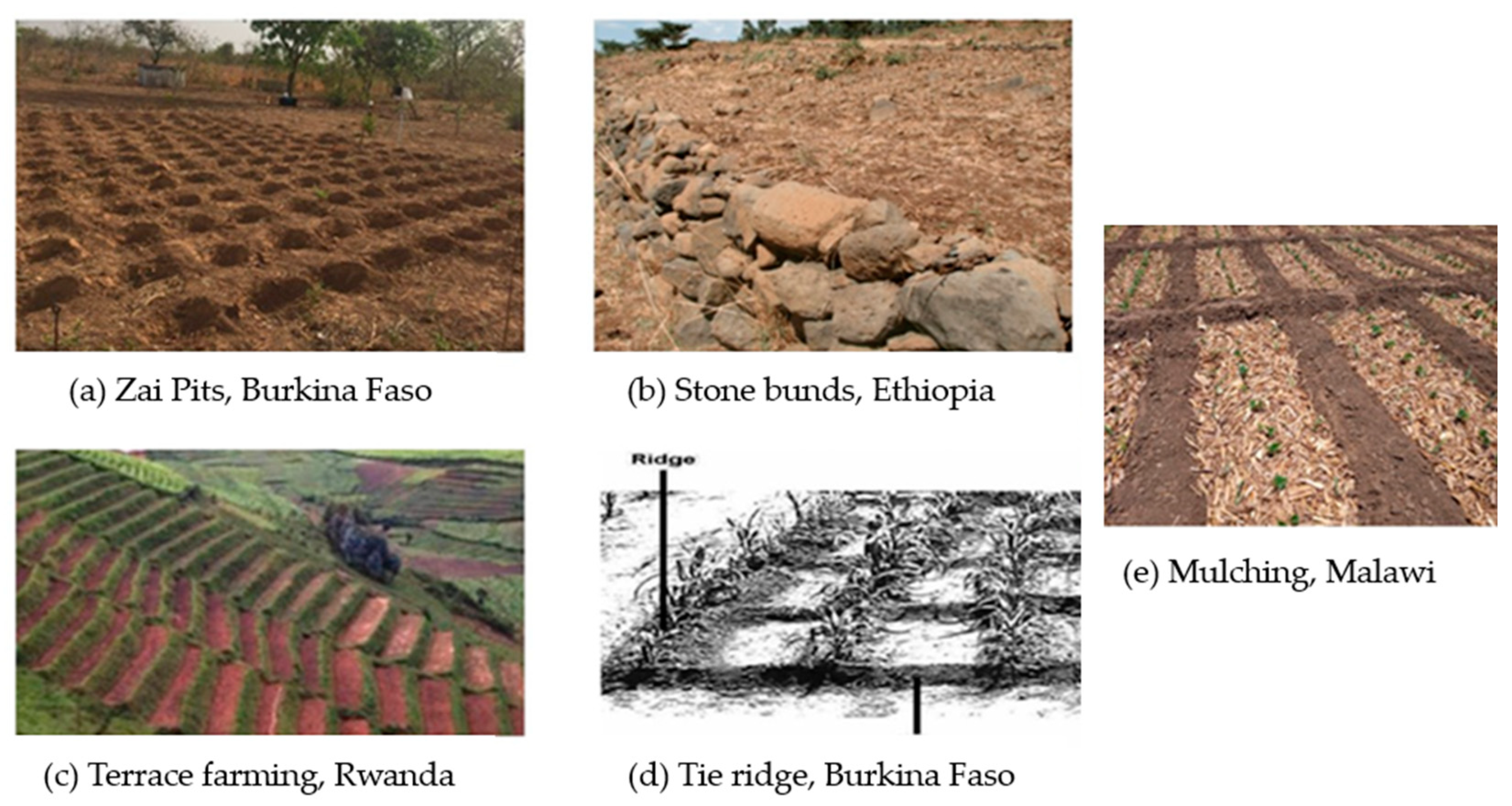
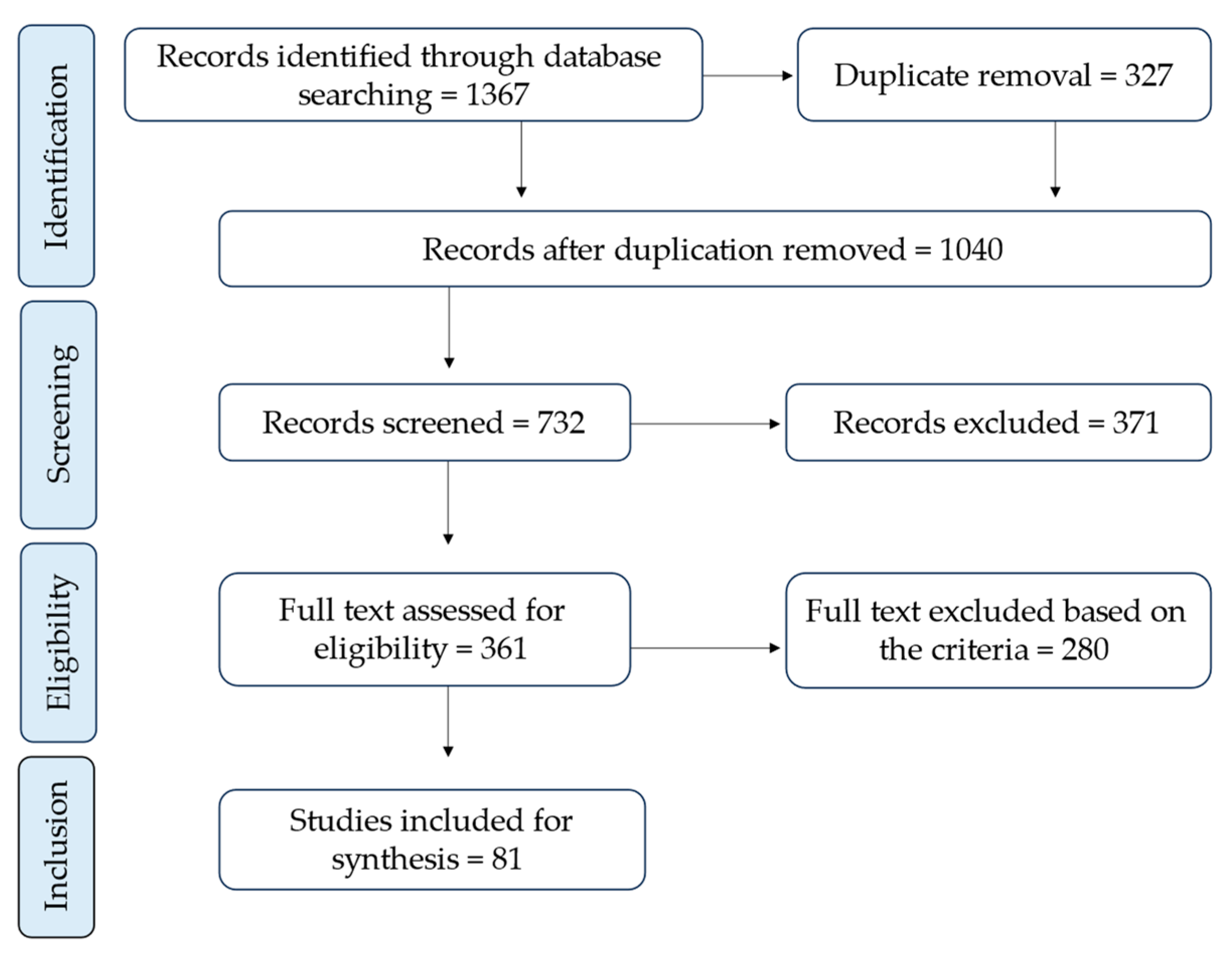



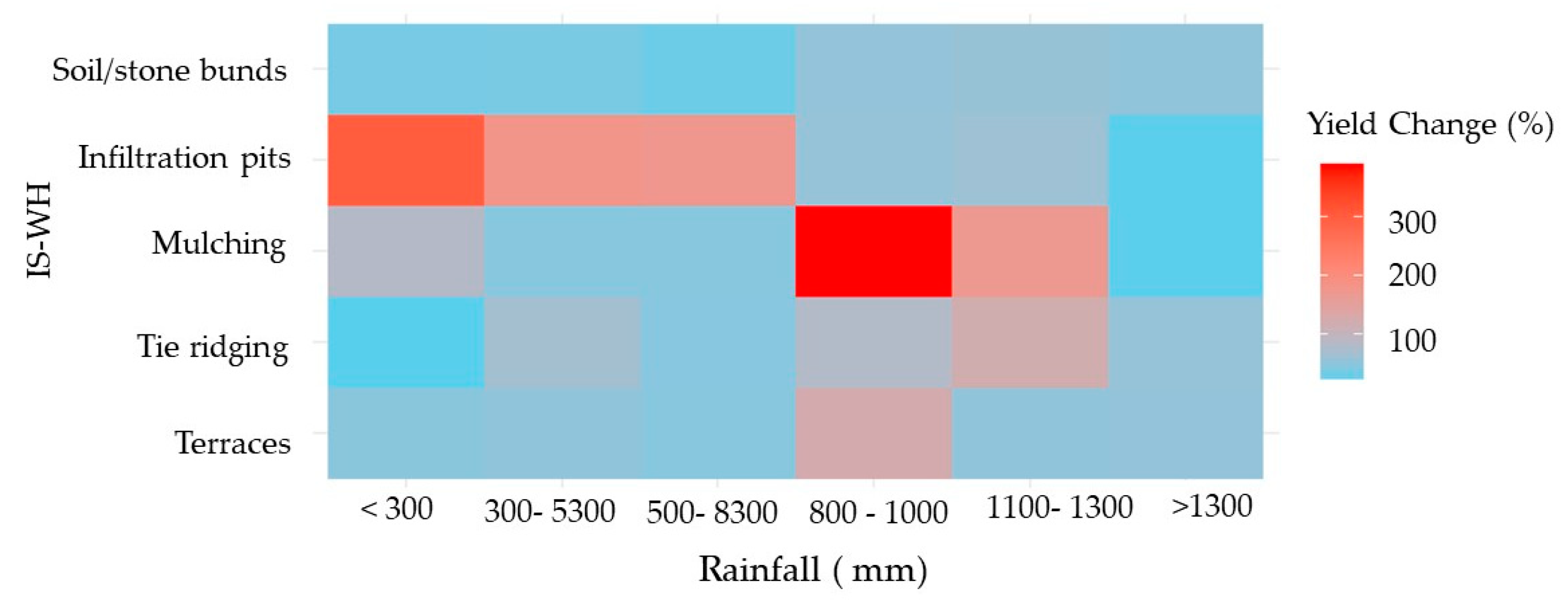


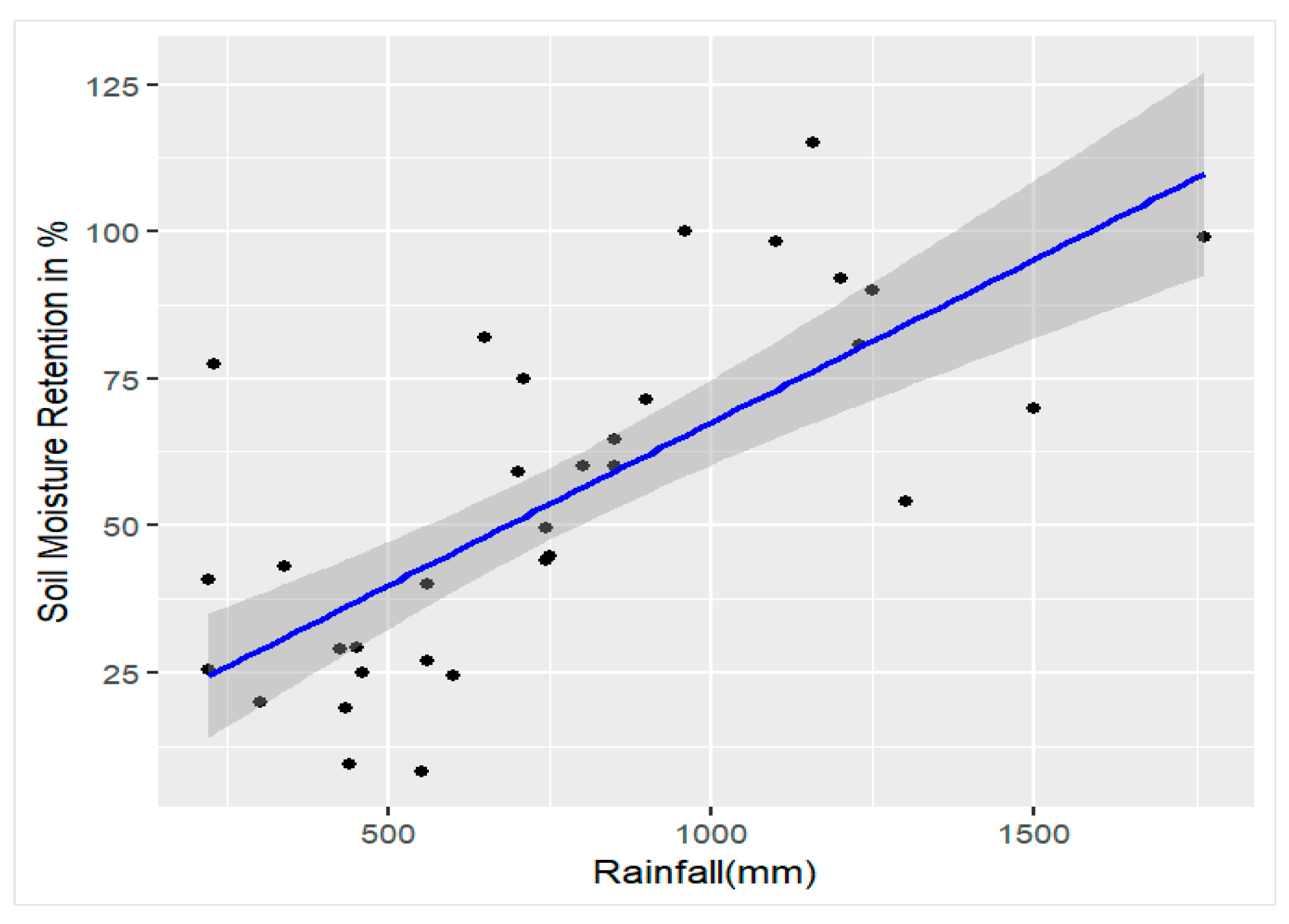


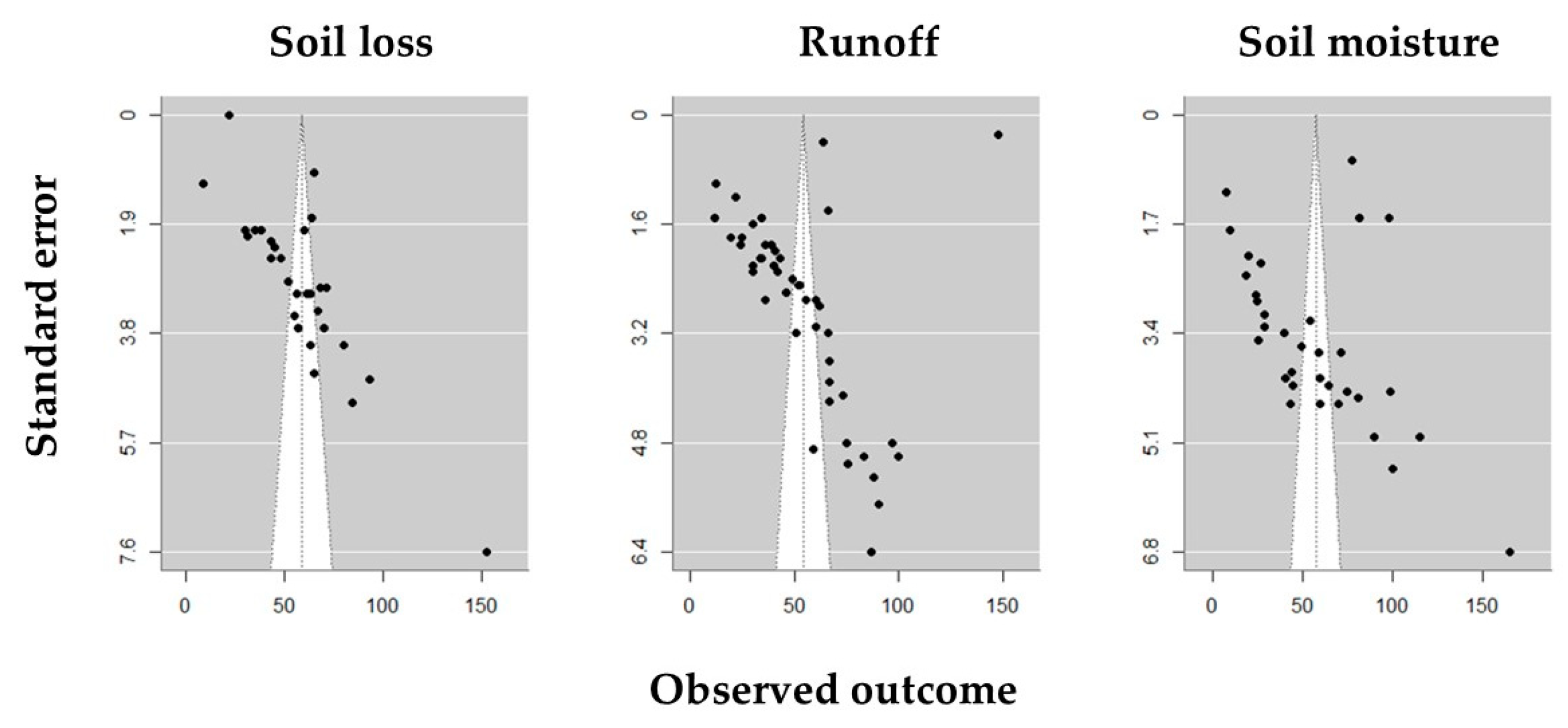

| IS_WH Practices | Brief Description | Distribution (%) in the Database |
|---|---|---|
| Infiltration/Percolation/Planting Pits | Designed to store rainwater around the root zone and allow crops to use it during dry spells (e.g., Zaï Pits, Tassa) [26,27]. | 19.6 |
| Bunds/soil and stone | Small embankments constructed across slopes to slow runoff and increase infiltration [28]. | 17.6 |
| Terraces | Flat platforms on slopes to prevent erosion and retain water (e.g., Fanya Juu) [29]. | 21.6 |
| Ridges | Earthen ridges across slopes to slow runoff and reduce erosion [30]. | 23.5 |
| Mulching | Covering soil with organic matter to reduce runoff and retain moisture [31]. | 17.6 |
| Characteristic | Description |
|---|---|
| Study Locations | 17 sub-Saharan African countries (Figure 1) |
| IS_WH practices | Soil/stone bunds, tied ridging, mulching, infiltration pits, others (Table 1) |
| Study Durations | 1 growing season (32%), 2 growing seasons (56%), 3 or more growing seasons (12%) |
| Crops Studied | Maize, sorghum, other (bean, chickpea, cowpea, wheat, teff, millet, barley, tomato, onion, potato, banana, coffee, watermelon, and pepper) |
| Outcomes Measured | Crop yield (with and without fertilizer use), soil moisture, soil loss, runoff, rainfall variability, and adoption factors for each IS_WH practice |
| Sources | Journal articles (76), book sections (3), and reports (2) |
Disclaimer/Publisher’s Note: The statements, opinions and data contained in all publications are solely those of the individual author(s) and contributor(s) and not of MDPI and/or the editor(s). MDPI and/or the editor(s) disclaim responsibility for any injury to people or property resulting from any ideas, methods, instructions or products referred to in the content. |
© 2024 by the authors. Licensee MDPI, Basel, Switzerland. This article is an open access article distributed under the terms and conditions of the Creative Commons Attribution (CC BY) license (https://creativecommons.org/licenses/by/4.0/).
Share and Cite
Tefera, M.L.; Seddaiu, G.; Carletti, A. Traditional In Situ Water Harvesting Practices and Agricultural Sustainability in Sub-Saharan Africa—A Meta-Analysis. Sustainability 2024, 16, 6427. https://doi.org/10.3390/su16156427
Tefera ML, Seddaiu G, Carletti A. Traditional In Situ Water Harvesting Practices and Agricultural Sustainability in Sub-Saharan Africa—A Meta-Analysis. Sustainability. 2024; 16(15):6427. https://doi.org/10.3390/su16156427
Chicago/Turabian StyleTefera, Meron Lakew, Giovanna Seddaiu, and Alberto Carletti. 2024. "Traditional In Situ Water Harvesting Practices and Agricultural Sustainability in Sub-Saharan Africa—A Meta-Analysis" Sustainability 16, no. 15: 6427. https://doi.org/10.3390/su16156427





